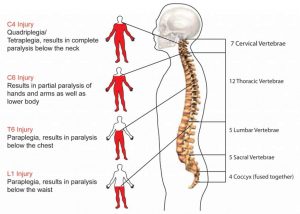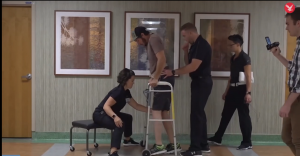To many, the concept of paralysis is terrifying. The simple thought of being conscious and aware, yet unable to move is enough to make even the bravest people uncomfortable. Unfortunately, for many people, this is their reality. An article by Cleveland Clinic estimates that roughly one in fifty Americans suffer from some form of paralysis. Added up, this is almost six million people!
Paralysis is caused by nerve damage rather than physical damage. For example, your legs could be paralyzed without actually having any noticeable injury. The two main causes of paralysis are currently stroke (33.7%), and spinal cord injuries (27.3%). Jerred Chinnock, a 29 year old man from Wisconsin, was a victim of the latter. After a snowmobile accident in, he suffered a spinal cord injury, and was paralyzed from the waist down. There are many types of spinal cord injuries and based on the image below, it’s likely that Jerred suffered from an “L1 Injury”. An injury to his lower spine, that would result in waist down paralysis.

Image credit: Profusion Rehab
However, determined to not lose hope, Jerred visited doctors in Minnesota, where they were able to accomplish something never done before- allow Jerred to move again. Although technology helping paralyzed people regain movement is not something thats unheard of, this case was very unique. Up to this point, reacquiring movement had to be done with technology such as braces that were electrically powered. While it allows for movement, the actual “moving” is done by the braces and not the human. It’s similar to using a remote to control your own legs! The doctors were able to overcome this by implanting electrodes into Jerred’s back. Since paralysis is mainly due to nerve damage, these electrodes are able to stimulate the existing nerves and allow control of legs similar to what was possible before the injury. Rather than relying on technology to walk for you, this method is much more similar to actually walking.
“The reason why this is important is because the patient’s own mind, thought, was able to drive movement in his legs. Just as important is that we were able to get him to stand independently and take his own steps.” – neurosurgeon Dr Kendall Lee
Video of Jerred and his treatment.

Experts help paralyzed man walk again, with assistance, by reactivating spinal cord
Belowis an image of Jerred practicing walking with the implants. While he still require’s a front-wheeled walker, he has been able to reach a few milestones such as walking sixteen minutes without stopping, as well as a hundred meters.

Jerred being trained to walk again.
Image credit: Independent UK
Although this method of treatment is in its very early states of testing, the current results are promising. With further improvements these implants could solve one of medicines greatest roadblocks, and in America alone, save millions of lives.
Elvis Kuan
